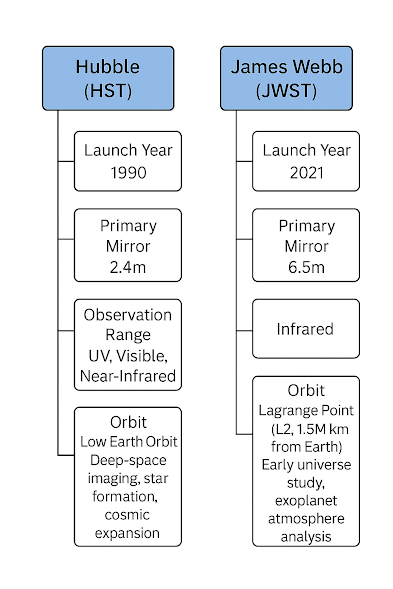Hubble Space Telescope (HST)
- Get link
- X
- Other Apps
Hubble Space Telescope (HST)
The Hubble Space Telescope (HST) is one of the most significant astronomical observatories ever launched. Since its deployment in 1990, it has transformed our understanding of the universe by capturing breathtaking images and making groundbreaking discoveries.
Key Features of Hubble
Launch Date: April 24, 1990, aboard the Space Shuttle Discovery.
Orbit: Low Earth Orbit (LEO) at 537 km altitude.
Primary Mirror: 2.4 meters in diameter.
Scientific Instruments:
Wide Field Camera 3 (WFC3) – Captures high-resolution images.
Cosmic Origins Spectrograph (COS) – Studies distant galaxies.
Advanced Camera for Surveys (ACS) – Maps cosmic structures.
Near Infrared Camera and Multi-Object Spectrometer (NICMOS) – Observes infrared light.
Recent Discoveries
Cotton Candy Clouds in the Large Magellanic Cloud – Hubble captured a stunning view of a dwarf galaxy, revealing wispy gas clouds.
Wandering Black Hole – Detected a rogue supermassive black hole outside its galaxy.
35th Anniversary Celebrations – NASA and ESA released new images showcasing Hubble’s legacy
The Hubble Space Telescope (HST), launched by NASA in collaboration with ESA, has revolutionized astronomy and deep-space observation. It aligns with multiple topics relevant to UPSC preparation, particularly in GS Paper 3 (Science & Tech, Space Research).
UPSC Key Areas
✅ Scientific Contributions – Expanded knowledge of the universe’s age, black holes, exoplanets, and dark matter.
✅ Technological Innovation – Development of adaptive optics, infrared astronomy, and spectroscopic analysis.
✅ International Collaboration – NASA-ESA partnership in space research, crucial for India’s collaborations with ISRO and ESA.
✅ Future Space Missions – Comparison with James Webb Space Telescope (JWST) and India’s ASTROSAT mission.
Hubble vs. James Webb – UPSC Significance
Feature | Hubble (HST) | James Webb (JWST) |
|---|---|---|
Launch Year | 1990 | 2021 |
Primary Mirror | 2.4m | 6.5m |
Observation Range | UV, Visible, Near-Infrared | nfrared |
Orbit | Low Earth Orbit | Lagrange Point (L2, 1.5M km from Earth) |
| Objective | Deep-space imaging, star formation, cosmic expansion | Early universe study, Exoplanet atmosphere analysis |
UPSC Themes Linked to Hubble
✅ GS Paper 1 – Evolution of the Universe, impact of astronomical discoveries on history.
✅ GS Paper 3 – Space technology advancements, ISRO’s future missions like Gaganyaan & ASTROSAT.
✅ Current Affairs – Role of HST in recent discoveries like rogue black holes and exoplanet atmospheres.
- Get link
- X
- Other Apps



Comments